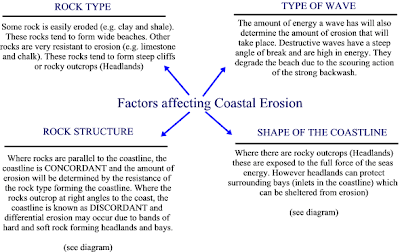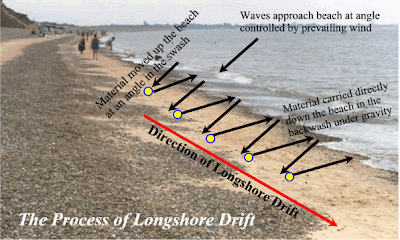Remember, there are 3 main processes that cause a coastline to change:
1. Erosion
2. Transport
3. Deposition.
There are number of factors which affect each of these processes - we are going to start by exploring erosion processes and the factors that can affect the amount of erosion that may take place along a coastline.
COASTAL EROSION
Erosion Processes:
Erosion is the wearing away of rocks, at the coast there are 6 main types of erosion processes in action.
1. ABRASION (this is also known as corrasion) - this is where rock fragments are hurled at cliffs by breaking waves, gradually scraping away at the cliff face;
2. HYDRAULIC ACTION - as waves break against the cliff face, the pressure of the breaking wave can compress air in cracks. This compressed air gradually forces open the crack in the rock - as this process continues, the rock becomes increasingly weakened.
3. SOLUTION (this is also known as corrosion) - this occurs where the salt water is able to dissolve some of the chemicals in rocks - for example, limestone cliffs are gradually weakened as the salt water dissolves the calcium carbonate in the limestone.
4. SCOURING - this occurs at the base of the cliff as the waves break and swirl around, gradually removing loose rock.
5. ATTRITION - this is where rock fragments carried by the waves hit against each other and gradually wear down to form sand and silt
6. WAVE POUNDING - the sheer force of waves hitting against the cliff face
These processes of erosion form a series of distinctive Landforms at the coast.
Rates of Coastal Erosion
So what are the factors that determine how much erosion can take place at the coast?
1. The Resistance of the Rocks - e.g. limestone, chalk and granite are resistant rocks (often forming cliffs and headlands) and erode relatively slowly, whilst less resistant rocks such as clay are easily eroded.
2. The Strength of the waves - affected by the wind strength and duration and its fetch
3. The shape of the coastline (which is dependent on its geology) - on concordant coastlines, rocks are parallel to the wave front and therefore rates of erosion are similar along the coastline. On discordant coastlines, differential erosion may occur, where bands of hard and soft rock outcrop at right angles to the sea. Consequently headlands and bays form along discordant coastlines and whilst headlands remain exposed to the force of the waves, bays are sheltered.
COASTAL TRANSPORT
The second process operating at the coast is transport. Material eroded by the sea is carried within the water in a number of ways, minerals dissolved from rocks are carried in solution, whilst small rock fragments, light enough to be held within the water, float in suspension. The largest rock fragments which are too heavy to be picked up by the waves, are transported by the process of traction, this is where they roll along the bed when the waves pick up enough energy. Finally, medium sized rock particles, which cannot be carried by the waves all the time, are moved by saltation. This is where during times of higher wave energy the particles are picked up and then dropped again as the wave looses its energy.
The main form of transport operating at the coast is that of LONGSHORE DRIFT.
Longshore drift is the process by which sand and pebbles are moved along a beach by the movement of the waves.
COASTAL DEPOSITION
Material is moved up the beach by the swash at an angle which is controlled by the prevailing wind. The backwash then carries material back down the beach at right angles to the coastline under the influence of gravity. Gradually the material is moved along the coastline, its direction being controlled by the prevailing wind direction.
The final process operating at the coast is that of deposition - this is where material that is too heavy to be transported any more is left behind, building up the beach. Due to the importance of energy in transporting sand and shingle, it is the largest material that is deposited first. A number of distinctive features may form due to coastal deposition.
Key Terms Check:
- Erosion - the wearing away and removal of material
- Deposition - the dropping of material
- Abrasion - the wearing of rock due to rock fragments being hurled against cliffs
- Attrition - the breakdown of rocks as they hit against each other
- Hydraulic Action - the force of waves causing rocks to split apart as waves compress air in cracks in the rocks
- Wave Pounding - sheer force of water hitting rocks
- Solution - where minerals in rocks are dissolved by the action of sea water
- Scouring - occurs where water and broken rock fragments swirl around at the base of cliffs gradually wearing rock away.
- Longshore Drift - the movement of material along a coastline
Do you like this post? Please link back to this article by copying one of the codes below.
URL: HTML link code: BB (forum) link code:




